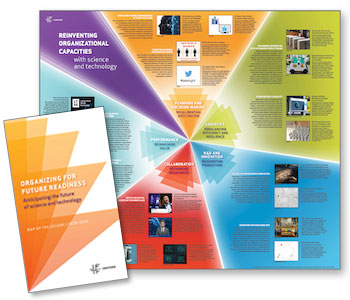Organizing for Future Readiness

Chart a course for transformational opportunities
The digital transformation that has already remade our global systems will continue to disrupt, mature, and be accelerated by advances in information technology—a process that was kickstarted by the demands of adapting to COVID-19.
But technical change won’t just come from digital technologies. A combination of advances from biotech, energy, and materials science are maturing and will open new frontiers in innovation and organizational strategy as well as profound new risks.
These advances are taking place in an environment in which short-term competitive pressures have never felt more intense or urgent. As these pressures intensify, they threaten to erode organizational abilities to take the long view, prepare for the daunting challenges of the next decade, and build the capacity to lead.

The 2020–2030 Map of the Decade, Organizing for Future Readiness: Anticipating the future of science and technology, focuses on understanding the evolution of three overlapping phenomena over the next ten years:
Building blocks examine the foundational innovations taking place in:
1 | Information Technology
2 | Energy
3 | Materials Science
4 | Biology
Organizational capacities forecast how these building blocks will be combined to shape innovation across five key organizational functions: Planning, Logistics, R&D, Collaboration, and Performance.
Industry forecasts drill down to highlight how these new organizational capacities will play out in seven domains: Food, Health, Communications, Finance, Mobility, Retail, and Manufacturing.
How to Use This Map
IFTF Vantage’s Map of the Decade provides an executive summary of our complete set of research materials (available exclusively to IFTF Vantage partners) on Organizing for Future Readiness: Anticipating the Future of Science and Technology. It takes a ten-year view of the science and technology landscape by examining four key areas:
- Start by exploring the Building Blocks to learn about the future of Information Technology, Materials Science, Biology, and Energy in the coming decade.
- Next, identify emerging and unexpected opportunities that combine these building blocks through reinvented Organizational Capacities that future-ready organizations will use to develop resilient systems.
- After that, familiarize yourself with the Industry Forecasts emerging from the new organizational capacities, which lay out how industries will achieve future readiness.
- Finally, turn to the Map side to learn about early signals that point to a future in which advances in science and technology will play leading roles in radically reshaping the way we organize and interact with larger systems.
Organizing for future readiness involves developing and maintaining a point of view about long-term possibilities through foresight—and using that point of view to develop insight about what these possibilities might mean in order to shape action in the present.
Get In Touch!
Interested in engaging with early research exclusively available to IFTF Vantage partners?
John Clamme | jclamme@iftf.org | 650-233-9517



